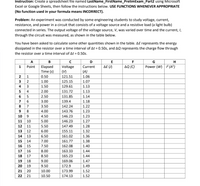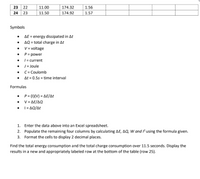
Introductory Circuit Analysis (13th Edition)
13th Edition
ISBN: 9780133923605
Author: Robert L. Boylestad
Publisher: PEARSON
expand_more
expand_more
format_list_bulleted
Question
what functions of formula should I use for me to get the value of the following empty rows and columns

Transcribed Image Text:Instruction: Create a spreadsheet file named LastName_FirstName_PrelimExam_Part2 using Microsoft
Excel or Google Sheets, then follow the instructions below. USE FUNCTIONS WHENEVER APPROPRIATE
(No function used in your formula means INCORRECT).
Problem: An experiment was conducted by some engineering students to study voltage, current,
resistance, and power in a circuit that consists of a voltage source and a resistive load (a light bulb)
connected in series. The output voltage of the voltage source, V, was varied over time and the current, I,
through the circuit was measured, as shown in the table below.
You have been asked to calculate some other quantities shown in the table. AE represents the energy
dissipated in the resistor over a time interval of At = 0.50s, and AQ represents the charge flow through
the resistor over a time interval of At = 0.50s.
A
в
D
F
G
H
1 Point
ΔQ (C)
Power (W) P (A²)
Elapsed
Time (s)
Voltage
(V)
Current
ΔΕ )
(A)
2 1
3 2
4 3
0.50
121.51
1.06
1.00
125.15
1.07
1.50
129.61
1.13
5
4
2.00
131.72
1.13
6 5
7
2.50
131.85
1.14
6
3.00
139.4
1.18
8
7
3.50
142.24
1.22
9 8
4.00
143.76
1.23
10 9
4.50
146.23
1.23
11 10
12 11
5.00
146.23
1.27
5.50
147.49
1.28
13 12
6.00
155.11
1.32
14 13
6.50
161.02
1.36
15 14
7.00
161.77
1.38
16 15
7.50
162.08
1.40
17 16
8.00
163.33
1.44
18 17
19 18
20 19
21 20
8.50
165.23
1.44
9.00
169.06
1.47
9.50
172.9
1.49
10.00
173.99
1.52
22
21
10.50
174.13
1.52

Transcribed Image Text:23 22
11.00
174.32
1.56
24 23
11.50
174.92
1.57
Symbols
• AE = energy dissipated in At
• AQ = total charge in At
• V = voltage
• P= power
• = current
• J = Joule
• C = Coulomb
At = 0.5s = time interval
Formulas
• P= (1)(V) = AE/At
• V = AE/AQ
• I = AQ/At
1. Enter the data above into an Excel spreadsheet.
2. Populate the remaining four columns by calculating AE, AQ, W and Pusing the formula given.
3. Format the cells to display 2 decimal places.
Find the total energy consumption and the total charge consumption over 11.5 seconds. Display the
results in a new and appropriately labeled row at the bottom of the table (row 25).
Expert Solution
This question has been solved!
Explore an expertly crafted, step-by-step solution for a thorough understanding of key concepts.
Step by stepSolved in 2 steps

Knowledge Booster
Learn more about
Need a deep-dive on the concept behind this application? Look no further. Learn more about this topic, electrical-engineering and related others by exploring similar questions and additional content below.Similar questions
- An assembly consists of electrons and total charge of electrons is -5C. What will be total mass of the assembly?arrow_forwardI think I need help with the algebra in here. how do you arrive at 3/4 R1 . Also it os still unclear to me how do you set up the equation (multiply resistors on top/adding them at bottom)arrow_forwardcould you use euler formula,i want to compare if i did it correctly with thatarrow_forward
- Please ignore the values that are written those are based off the IP value. I need real help determining the V and I for each resistor. Please see the image attached.arrow_forwardcan someone explain to me the logic how to do this problem step by step I have the answers but I want to know how to do each part and understand the concepts of what is happeningarrow_forwardwhy are you using the high voltage to find the open circuit angle in step 1? isnt the low voltage supposed to be applied in the open-circuit test?arrow_forward
arrow_back_ios
arrow_forward_ios
Recommended textbooks for you
 Introductory Circuit Analysis (13th Edition)Electrical EngineeringISBN:9780133923605Author:Robert L. BoylestadPublisher:PEARSON
Introductory Circuit Analysis (13th Edition)Electrical EngineeringISBN:9780133923605Author:Robert L. BoylestadPublisher:PEARSON Delmar's Standard Textbook Of ElectricityElectrical EngineeringISBN:9781337900348Author:Stephen L. HermanPublisher:Cengage Learning
Delmar's Standard Textbook Of ElectricityElectrical EngineeringISBN:9781337900348Author:Stephen L. HermanPublisher:Cengage Learning Programmable Logic ControllersElectrical EngineeringISBN:9780073373843Author:Frank D. PetruzellaPublisher:McGraw-Hill Education
Programmable Logic ControllersElectrical EngineeringISBN:9780073373843Author:Frank D. PetruzellaPublisher:McGraw-Hill Education Fundamentals of Electric CircuitsElectrical EngineeringISBN:9780078028229Author:Charles K Alexander, Matthew SadikuPublisher:McGraw-Hill Education
Fundamentals of Electric CircuitsElectrical EngineeringISBN:9780078028229Author:Charles K Alexander, Matthew SadikuPublisher:McGraw-Hill Education Electric Circuits. (11th Edition)Electrical EngineeringISBN:9780134746968Author:James W. Nilsson, Susan RiedelPublisher:PEARSON
Electric Circuits. (11th Edition)Electrical EngineeringISBN:9780134746968Author:James W. Nilsson, Susan RiedelPublisher:PEARSON Engineering ElectromagneticsElectrical EngineeringISBN:9780078028151Author:Hayt, William H. (william Hart), Jr, BUCK, John A.Publisher:Mcgraw-hill Education,
Engineering ElectromagneticsElectrical EngineeringISBN:9780078028151Author:Hayt, William H. (william Hart), Jr, BUCK, John A.Publisher:Mcgraw-hill Education,

Introductory Circuit Analysis (13th Edition)
Electrical Engineering
ISBN:9780133923605
Author:Robert L. Boylestad
Publisher:PEARSON

Delmar's Standard Textbook Of Electricity
Electrical Engineering
ISBN:9781337900348
Author:Stephen L. Herman
Publisher:Cengage Learning

Programmable Logic Controllers
Electrical Engineering
ISBN:9780073373843
Author:Frank D. Petruzella
Publisher:McGraw-Hill Education

Fundamentals of Electric Circuits
Electrical Engineering
ISBN:9780078028229
Author:Charles K Alexander, Matthew Sadiku
Publisher:McGraw-Hill Education

Electric Circuits. (11th Edition)
Electrical Engineering
ISBN:9780134746968
Author:James W. Nilsson, Susan Riedel
Publisher:PEARSON

Engineering Electromagnetics
Electrical Engineering
ISBN:9780078028151
Author:Hayt, William H. (william Hart), Jr, BUCK, John A.
Publisher:Mcgraw-hill Education,